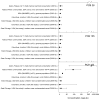PCBs and OH-PCBs in serum from children and mothers in urban and rural U.S. communities
- PMID: 23452180
- PMCID: PMC3645264
- DOI: 10.1021/es304455k
PCBs and OH-PCBs in serum from children and mothers in urban and rural U.S. communities
Erratum in
- Environ Sci Technol. 2013 Aug 20;47(16):9555-6
Abstract
East Chicago, Indiana is a heavily industrialized community bisected by the Indiana Harbor and Ship Canal, which volatilizes ~7.5 kg/yr polychlorinated biphenyls (PCBs). In contrast, the rural Columbus Junction, Iowa area has no known current or past PCB industrial sources. Blood from children and their mothers from these communities were collected April 2008 to January 2009 (n = 177). Sera were analyzed for all 209 PCBs and 4 hydroxylated PCBs (OH-PCBs). Sum PCBs ranged from nondetect to 658 ng/g lw (median = 33.5 ng/g lw). Sum OH-PCBs ranged from nondetect to 1.2 ng/g fw (median = 0.07 ng/g fw). These concentrations are similar to those reported in other populations without high dietary PCB intake. Differences between the two communities were subtle. PCBs were detected in more East Chicago mothers and children than Columbus Junction mothers and children, and children from East Chicago were enriched in lower-molecular weight PCBs. East Chicago and Columbus Junction residents had similar levels of total and individual PCBs and OH-PCBs in their blood. Concentrations of parent PCBs correlated with concentrations of OH-PCBs. This is the first temporally and methodologically consistent study to evaluate all 209 PCBs and major metabolites in two generations of people living in urban and rural areas of the United States.
Figures






References
-
- Erickson MD, Kaley RG. Applications of polychlorinated biphenyls. Environ Sci Pollut R. 2011;18(2):135–151. - PubMed
-
- Letcher RJ, Klasson-Wehler E, Bergman A. Methyl sulfone and hydroxylated metabolites of polychlorinated biphenyls. In: Paasivirta J, editor. New Types of Persistent Halogenated Compounds. Vol. 3. Springer-Verlag: Berlin-Heidelberg; 2000. pp. 315–359.
-
- Boas M, Feldt-Rasmussen U, Main KM. Thyroid effects of endocrine disrupting chemicals. Mol Cell Endocrinol. 2012;355(2):240–248. - PubMed
-
- Grandjean P, Landrigan PJ. Developmental neurotoxicity of industrial chemicals. Lancet. 2006;368(9553):2167–2178. - PubMed
Publication types
MeSH terms
Substances
Grants and funding
LinkOut - more resources
Full Text Sources
Other Literature Sources
Medical
Miscellaneous

